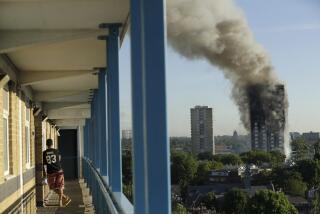Poor decisions set the stage for Deepwater Horizon disaster, panel finds
Reporting from Washington â Failure to manage the risks of a complex well and to learn from an earlier narrowly missed disaster contributed significantly to the Deepwater Horizon disaster in the Gulf of Mexico, a panel investigating the BP oil spill said Wednesday.
âNumerous decisionsâ to continue operations despite repeated warnings of problems âsuggest an insufficient consideration of risk and a lack of operating discipline,â according to a report issued by a committee at the National Academy of Engineering/National Research Council, which was convened at the request of Interior Secretary Ken Salazar.
The report, an interim document, is the most recent in a series of findings that have gradually brought into sharper focus the many factors that led to the explosion and sinking of the Deepwater Horizon drilling rig, which killed 11 workers and unleashed the worst offshore oil spill in U.S. history. More detailed answers are months away. This week, a forensics investigation began on the battered blowout preventer, a series of valves that failed to seal the runaway well.
Wednesdayâs report seemed to confirm conclusions drawn last week by the presidential oil spill commission that managers on the rig made a series of inexplicably bad decisions at crucial times, most notably ignoring alarming results from tests of pressure inside the well.
The committee differed with the presidential panel, however, by more explicitly linking those decisions to financial considerations on the part of BP, which owned the federal lease to drill and rented the rig from Transocean Ltd.
âThey appear to be made in the direction of reduced schedule and reduced cost,â said Donald C. Winter, the committee chairman, former secretary of the Navy and professor at the University of Michigan, in a conference call. âThat causes us to question the overall risk management approach used and causes us to question the adequacy of checks and balances to weigh cost and time versus risk and safety.â
A BP statement said that the report did not include evidence the company believes points toward faulty cementing work by contractor Halliburton.
âThe report makes clear that the committee is continuing to investigate and has not yet considered evidence that has surfaced since October 1,â the statement said. âSuch evidence includes the cement tests conducted independently for the presidential commission suggesting that Halliburtonâs cement slurry was unstable. We will continue to cooperate with the committee to provide information and evidence to assist in its review.â
When the rig exploded on the night of April 20, the crew, made up of employees of BP, Transocean and other companies, were in the process of temporarily plugging the well before taking the rig to another site. They were more than 40 days behind schedule, costing BP millions of dollars.
The well was a ânightmare,â a BP engineer said in an internal e-mail message. BP and the others experienced a near-miss on March 8 that should have inspired more caution, the committee said. That day, the drilling mud sent into the well to lubricate the drill bit didnât circulate adequately back to the rig, indicating it probably leaked into sand formations around the well. The incident should have underscored the difficulty of the geology they were working in and âthe very narrow range of safe operating pressuresâ available to them, the report said.
BP and Halliburton also had test results weeks before the explosion indicating that the cement they planned to use would not seal the bottom of the well. They proceeded anyway. âQuestions have been raised about the strength of the foam cement used in the well and whether sufficient time was allowed for the cement to set and gain strengthâ before a key test was run, the report said.
But the âpivotalâ event occurred two hours before the explosion, when BP and its contractors ran a ânegative pressure testâ to examine the integrity of the wellâs cement seals, said Paul M. Bommer, a lecturer in petroleum engineering at the University of Texas and a member of the committee. The Deepwater Horizon team ran the test several times, each resulting in abnormal pressure readings.
Top managers on the rig declared the test a success, however, and the crew continued its work, as dangerous natural gas shot into the well. âWhen they went ahead, their options narrowed greatly,â Bommer said. âThat was a key moment.â
The engineers on the committee said they had not gotten a satisfactory answer to why the rig crew considered the pressure test results to be successful. The BP âcompany man,â or lead manager on the rig, Robert Kaluza, has so far declined to testify in any hearings, including those the committee held.
Before issuing a final report in June, Winter said, the committee plans to look into several issues more deeply, including the cementing job and the blowout preventer. The committee heard from BP during its hearings, but Transocean, the rigâs owner, and Cameron, the maker of blowout preventer, did not testify or provide data or design detail about the device.
Cameron declined to explain why it did not testify. A Transocean spokesman declined to comment on the companyâs absence from the hearings. Of the reportâs findings, the spokesman said in an e-mail: âThe men who lost their lives on April 20th had a combined total of roughly 80 years of experience, and were considered to be among the best in the business. The company stands behind them.â
More to Read
Sign up for Essential California
The most important California stories and recommendations in your inbox every morning.
You may occasionally receive promotional content from the Los Angeles Times.











